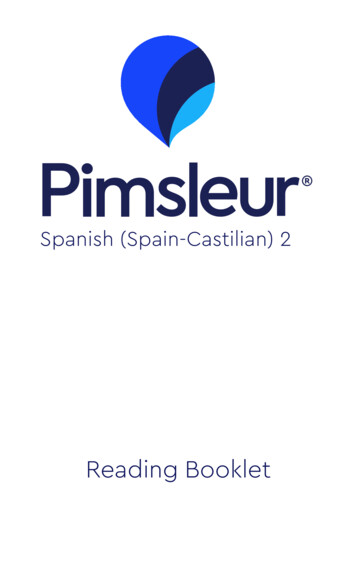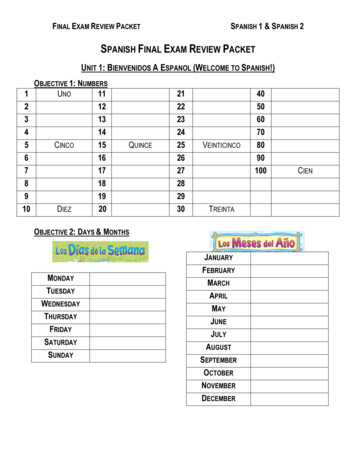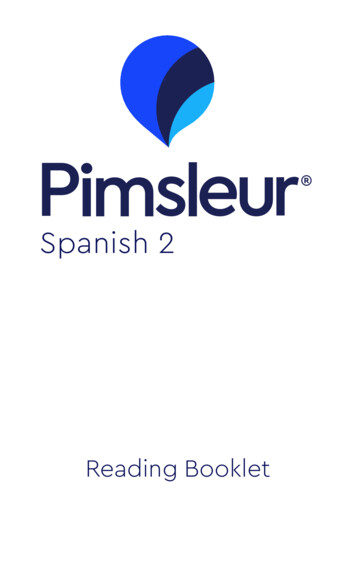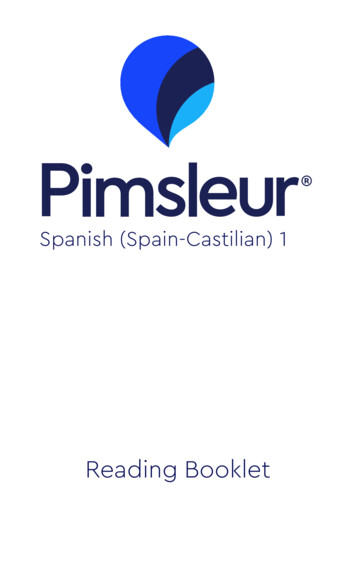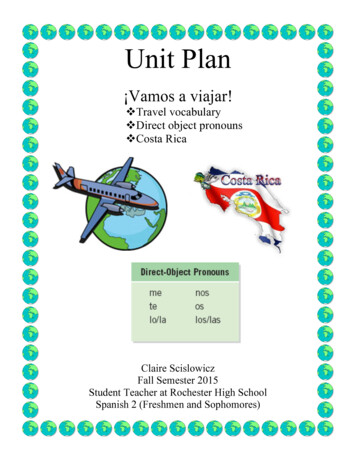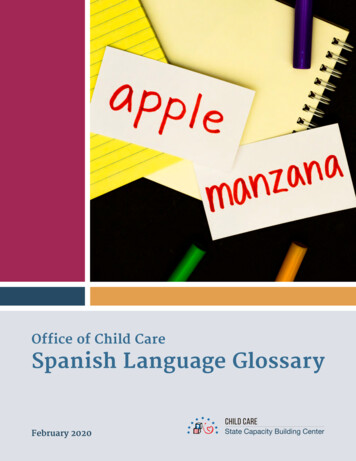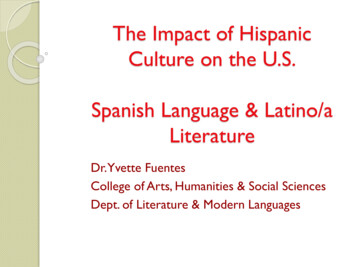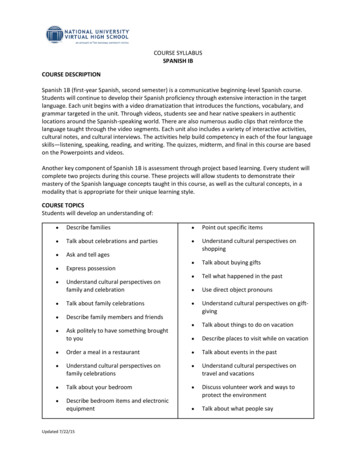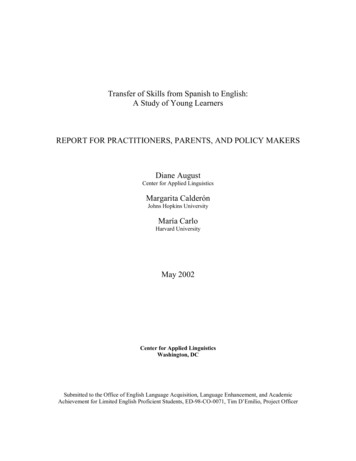
Transcription
Transfer of Skills from Spanish to English:A Study of Young LearnersREPORT FOR PRACTITIONERS, PARENTS, AND POLICY MAKERSDiane AugustCenter for Applied LinguisticsMargarita CalderónJohns Hopkins UniversityMaría CarloHarvard UniversityMay 2002Center for Applied LinguisticsWashington, DCSubmitted to the Office of English Language Acquisition, Language Enhancement, and AcademicAchievement for Limited English Proficient Students, ED-98-CO-0071, Tim D’Emilio, Project Officer
The work reported herein was supported under Contract Number ED-98-CO-0071, asadministered by the Office of English Language Acquisition, Language Enhancement,and Academic Achievement for Limited English Proficient Students (OELA), U.S.Department of Education. However, the contents do not necessarily represent thepositions or policies of the Office of English Language Acquisition or the U.S.Department of Education, and you should not assume endorsement by the FederalGovernment.
ContentsExecutive Summary .11Project Objectives and Design .4Project Objectives .4Rationale for Project Design.4Project Design.62Background: Skills Transfer from Spanish to English .9Phonological Processes.9Orthographic Skills .10Word and Pseudoword Reading.10Word Knowledge .11Comprehension Skills and Strategies.12Implications for Practice .13Implications for Research .133Major Findings of the Project.15Demographic Characteristics of the Groups .15Descriptive Statistics.15Responses to Research Questions.17Analyses Planned for the Fifth Wave of Data .21Implications of Findings for Practitioners and Policy Makers .21References.23Tables .25
Executive SummaryThe investigation documented in this report focused on understanding the mannerin which component skills of reading are transferable from Spanish to English. The studyexamined how performance on indicators of Spanish reading at the end of second gradepredicted English reading performance at the end of third and fourth grades. Weexamined transfer in the areas of phonological awareness, word reading, wordknowledge, and comprehension. We also evaluated whether transfer effects would bedifferent for Spanish-speaking children initially instructed in Spanish as compared withSpanish-speaking students instructed only in English.The study took place in Success for All (SFA)/Éxito para Todos schools inBoston, El Paso, and Chicago. We selected SFA schools because their curriculum isconsistent across sites; there are parallel versions in Spanish (Éxito para Todos) andEnglish; some children in SFA schools are instructed solely in Spanish before theytransition to English; and SFA is a research-based reading program that teaches allcomponent skills of literacy. At the heart of the program is 90 minutes of uninterrupteddaily reading instruction that emphasizes a balance between phonics and meaning, usingboth phonetically regular student text and children’s literature.We collected data from four to six classrooms at each site, depending on thenumber of target students available in each classroom. At the beginning of the study (endof second grade), a total of 287 students were participating. By the end of the fourthgrade, 189 students remained in the sample. Of these 189 students, 34 were monolingualEnglish speakers, 59 were Spanish–English bilingual students in English-only instruction,and 96 were Spanish–English bilingual students who received initial reading instructionin Spanish.Descriptive statistics indicate that at the end of fourth grade, English-instructedand Spanish-instructed students who received the highest scores on the WoodcockLanguage Proficiency Passage Comprehension Subtest are comparable in number (10Spanish-instructed students and 7 English-instructed students). However, when oneexamines these students’ Spanish language proficiency and reading test results, theSpanish-instructed students show grade level or above performance, while the Englishinstructed children are far below grade level except in word reading skills.1
Regression analysis, a method for identifying statistically significant correlationsbetween variables, was used to examine whether initial Spanish performance within eachcomponent of reading (phonological awareness, word reading, reading comprehension)would predict English performance at the end of third and fourth grades. In eachanalysis, we accounted for the possible contributions of general ability, oral Englishproficiency, performance in English on the reading measure of interest at the beginningof the study, and number of years of formal instruction in English reading. We also usedgrowth modeling to examine the effects of performance on the Spanish readingcomponents at the end of second grade on the rate of growth in English passagecomprehension between the end of second grade and the end of fourth grade, and to testthe effect of English oral proficiency on initial status and rate of growth in Englishpassage comprehension.The results indicated that Spanish phonemic awareness, Spanish letteridentification, and Spanish word reading were reliable predictors of performance onparallel tasks in English at the end of third and fourth grades, controlling for nonverbalability, English oral proficiency, and performance on the same English literacy task at thebeginning of the study. The effect of Spanish phonemic awareness on English phonemicawareness emerged for all students. However, the effect of Spanish letter identificationand Spanish word reading on English letter identification and English word readingemerged only for students who had received formal instruction in Spanish reading. Withregard to vocabulary knowledge, we found that the Spanish-instructed students knewsignificantly more cognates than the English-only instructed students, but the two groupsdid not differ in their knowledge of noncognates.With regard to passage comprehension, the results differed depending on whetherwe examined English passage comprehension at the end of fourth grade or growth inEnglish passage comprehension between second and fourth grades. We found a positiverelationship between Spanish passage comprehension at the end of second grade andEnglish passage comprehension at the end of fourth grade, controlling for English oralproficiency, nonverbal ability, and language of initial reading instruction. Using growthmodeling, however, we did not find a relationship between initial Spanish literacy skillsmeasured at the end of second grade and growth in passage comprehension betweensecond and fourth grades.We also investigated whether the effect of Spanish literacy on English literacyvaries with respect to level of Spanish literacy ability. The regression analyses weconducted did not provide evidence to suggest that the effect of Spanish literacy onEnglish literacy varied for differing levels of Spanish literacy. However, it should benoted that lack of variation among students on the assessment measures may havemasked a possible relationship.2
Further, we investigated whether the effect of Spanish phonemic segmentation,letter identification and word reading on the same component skills in English varies withrespect to level of English oral language proficiency. The analyses indicated no datasuggesting that differences in the magnitude of the relationship between Spanish andEnglish performance was a function of oral language proficiency. However, oral Englishproficiency might play a role in higher order component skills such as comprehension.Finally, with regard to group differences in English literacy outcomes and rate ofgrowth in English, results of growth models indicated that while Spanish-instructedstudents had lower overall performance on the English reading measures at the end offourth grade, their rate of growth in English was slightly greater than that of the Englishinstructed students.In future analyses, we hope to clarify some of the ambiguous results cited aboverelated to passage comprehension by using a different analytical approach—structuralequation modeling. The advantage of this approach is that it will enable us to define ourvariables—for example, Spanish literacy and oral English proficiency—using multipleobservable measures that tap into these constructs rather than a single observablemeasure. Another advantage is that we will be able to model growth in two outcomes—word reading and passage comprehension, for example—at once. This will be a realadvantage to the extent that we want to test differences in the effects of the primaryvariables on the outcome variables, or believe that the effects of these primary variablesare mediated or moderated through one of the two outcome variables. For example, theeffect of Spanish literacy on English passage comprehension may be through Englishword reading. We hope to use this analytical technique to reexamine two other keyresearch questions: (1) Does the effect of Spanish literacy on English literacy vary withrespect to level of Spanish literacy attained? (2) Does the effect of Spanish literacy onEnglish literacy vary with respect to the level of English oral proficiency?Finally, after the students have completed fifth grade, we hope to compare thefour groups of students (English monolingual students instructed in English, Spanishspeaking students instructed in English, Spanish-speaking students instructed in Spanishthrough second grade, and Spanish-speaking students instructed in Spanish through thirdgrade) on literacy outcomes, controlling for initial differences in factors that maypredispose one group to do better than another independently of language of literacyinstruction. Such factors include, but are not limited to, oral language proficiency,English literacy, and nonverbal intelligence.These preliminary findings support the practice of providing literacy instruction inSpanish to Spanish-speaking English-language learners as a means of helping themacquire literacy skills in English. By strengthening these students’ Spanish literacy, thispractice also enables them to use their native language well, enhancing their bilingualcapability.3
1Project Objectives and DesignWhile many studies have demonstrated some correlation between first-languagereading skills and second-language reading ability, in many cases the argument can bemade that factors not considered by the researchers (such as home learning environmentor students’ general ability levels) have affected study outcomes. The study described inthis report was designed to account for such factors. In addition to examining the transferof skills from Spanish to English, this study sought to examine the effects of level ofSpanish literacy and oral English proficiency on English literacy acquisition. Thischapter describes the project objectives and design. Chapter 2 provides backgroundinformation on skills transfer from Spanish to English. The major findings of the studyand their implications for practitioners and policy makers are presented in Chapter 3.PROJECT OBJECTIVESFour major research questions guided the design of this research project:1. Does cross-language transfer of skills take place?2. Does the effect of Spanish literacy on English literacy vary with respect tolevel of Spanish literacy?3. Does the effect of Spanish literacy on English literacy vary with respect tolevel of oral English proficiency?4. Are there group differences in literacy outcomes and rate of growth in Englishliteracy?RATIONALE FOR PROJECT DESIGNOur ability to address the questions listed above was contingent upon havingaccess to English-language learners who had (1) received instruction in Spanish readingprior to receiving instruction in English reading, (2) received instruction that targetedspecific component reading skills, (3) had a chance to develop a minimum level ofmastery of those skills, and (4) received comparable instruction across classrooms andsites. Our study population met all of these needs.4
First, one group of students in the study had received reading instruction inSpanish only before transitioning into English literacy instruction; the study examined thetransfer of Spanish reading skills as these children began to learn to read in English in thethird and fourth grades. Second, the children received targeted instruction in componentsof reading: phonological awareness, word reading, word knowledge, and comprehension.The study focused on the extent to which the levels of skill achieved in these componentsof early reading in Spanish could predict the types of gains these children would makeover the course of their third- and fourth-grade reading instruction in English. Third, thechildren had an opportunity to develop at least a minimum mastery of these skills becausemany of them had been instructed to read in Spanish since they were in kindergarten andcontinued in Spanish instruction through second grade and in some cases through thirdgrade. A comparison group of Spanish-background students had received readinginstruction only in English, using a curriculum parallel to the Spanish one. Fourth, allstudents in the study were exposed to the same literacy curriculum, Success for All(SFA)/Éxito para Todos (EPT).1 To ensure geographic diversity and thus some measureof generalizability, the study took place in SFA/EPT schools in three locations: Boston,El Paso, and Chicago.In designing the project, we recognized that a research design that proposes tostudy cross-language transfer of skills in a meaningful way must meet certain criteria.First, to demonstrate the occurrence of transfer of skills, the design must control for otherfactors that might affect a student’s performance on outcome assessments of Englishliteracy. We controlled for differences in children’s learning backgrounds and homelearning environments by collecting data on home language use and family readingpractices from parent questionnaires, and data on schooling history from school records.Using these data as one of the variables in our analysis enabled us to determine the extentto which these factors affected students’ English reading ability. We used a similarapproach to control for oral English proficiency and general ability level—the possibilitythat children with higher levels of English proficiency or higher intellectual abilitiesperform all tasks at higher levels than children with lower proficiencies and abilities. Weadministered the LAS-O, a measure of oral language proficiency, and the ColouredProgressive Matrices test, a measure of nonverbal ability, and used the test results ascontrol variables in our analyses. We also controlled for students’ initial proficiency inEnglish on the literacy task of interest to ensure that initial proficiency on this task wasnot the cause of transfer of skills.Finally, we controlled for variation in teaching methods by studying only childrenin schools that employ the SFA/EPT curriculum. This curriculum is based on currentresearch on the ways children learn to read and write. At the heart of the program is90 minutes of uninterrupted daily reading instruction that emphasizes a balance betweenphonics and meaning, using both phonetically regular student text and children’sliterature.51The SFA program has an English version (SFA) and a Spanish version (EPT).
The highly structured curriculum provides extensive guidance for teachers, helping toensure that all classroom instruction follows the same essential design. Children whoreceive literacy instruction in Spanish (EPT) generally transition into English instruction(SFA) in third or fourth grade.A second criterion for meaningful research on cross-language transfer is therecognition that literacy comprises many component skills. The component skills ofreading must be carefully assessed in the first and second language to trace thedevelopment of first- and second-language abilities in relation to one another. Ourresearch design used a combination of standardized and researcher-developed measuresto assess phonological awareness, phonemic segmentation (ability to divide words intotheir component sounds), word reading skills (letter recognition, word recognition, andability to read psuedowords), word knowledge skills, and comprehension skills in bothSpanish and English. We also tested for oral language ability in both languages. Theresearcher-developed measures were thoroughly piloted and revised on the basis ofpsychometric analyses of the pilot data.A third criterion for effective research on skills transfer is study over time. To becertain that students are transferring skills from their first language rather than usingskills learned in their second language, researchers must study subjects who havereceived reading instruction in their first language prior to receiving it in their secondlanguage, and who have received sufficient first-language instruction to have developed abase of first-language skills that can be transferred. If the time frame involved in shiftingfirst-language skills to reading comprehension in a second language is longer than thestudy period, the study results will show no transfer taking place—a misleadingconclusion. Our research design addressed these issues by studying bilingual studentsfrom the beginning of second grade through the end of fourth grade, the period of thisgrant, and we will continue to study these same children as they progress through fifthgrade. Approximately half of the students received reading instruction in Spanish insecond grade; some transitioned into English instruction in third grade, and the remaindertransitioned in fourth grade. We collected test data from a group of Englishmonolinguals and a group of Spanish–English bilinguals in English-only instruction forcomparison purposes.PROJECT DESIGNA total of 287 students in SFA/EPT programs in Boston, Chicago, and El Pasowere involved in the study at its beginning—when the students were at the end of secondgrade. Two years later, at the end of fourth grade, 189 students remained in the sample.Of these 189 students, 34 were English monolinguals, 59 were Spanish-speaking childrenin English-only instruction, and 96 were Spanish-speaking children who received initialreading instruction in Spanish. Of these 96, 34 were transitioned into all-English literacyinstruction at the beginning of third grade, and the others were transitioned into allliteracy instruction at the end of third grade.6
Over the course of the study, we collected data at four points in time from thesample of students: the end of second grade (Time 1, Spring 1999), the beginning ofthird grade (Time 2, Fall 1999), the end of third grade (Time 3, Spring 2000), and the endof fourth grade (Time 4, Spring 2001). At Time 1 and Time 2, we tested all studentsexcept the monolinguals in both Spanish and English so we could compare ability levelsacross languages at the same point in time. At Time 3 we tested students only in English.At Time 4 we tested all students in English and Spanish, since one objective was to learnwhich Spanish skills tested at the end of second grade could predict English performanceat the end of fourth grade, and another was to examine attrition in Spanish.The measures administered over the course of the study included both researcherdeveloped tests and standardized tests of the components of reading described above.The researcher-developed tests included the following: a phonology test and a phonemicsegmentation task (phonological awareness); a letter, word, and pseudoword naming task(word reading); and tests of cognate awareness and morphological awareness (wordknowledge). It should be noted that the scores used for letter, word, and pseudowordreading were reading efficiency scores created by combining reading accuracy withreading speed. The standardized tests administered included the Woodcock LanguageProficiency Battery (WLPB) letter-word and word attack subtests (word reading) and theWLPB passage comprehension test (reading comprehension). With the exception of thecognate awareness test, each of these measures was administered in parallel Spanish andEnglish versions. To assess oral language proficiency, we used the Spanish and Englishversions of the LAS-O, a test of oral proficiency, as well as the WLPB picture vocabularyand listening comprehension subtests.We used descriptive statistics to examine demographic variables related toreading as well as to compare reading outcomes for the two groups of students, thoseinstructed only in English and those instructed first in Spanish and then transitioned intoEnglish reading instruction. We also used descriptive statistics to highlight differences inlanguage proficiency and components of literacy among good and poor Englishcomprehenders, defined as those students from both groups (English-instructed andSpanish-instructed) who scored in the top and bottom third of the score distribution onthe Woodcock Language Proficiency Battery comprehension subtest.Another analytical strategy we employed was based on a three-step process. First,we examined simple correlations for Spanish performance on each of the readingcomponent tasks at the end of second grade and English performance on the same tasks atthe same time. The tasks included phonemic segmentation, letter reading efficiency,word reading efficiency, and pseudoword reading efficiency. Next we also examined thesimple correlations for Spanish performance at the end of second grade with Englishperformance on the same tasks at the end of third grade and end of fourth grade.7
The third step involved examining the relationship between Spanish performance at theend of second grade and English performance at the end of third grade and end of fourthgrade through a series of regression analyses. This technique allowed us to test therelationships between initial factors (initial reading performance in Spanish) and outcomefactors (performance in English reading at the end of third and fourth grades), controllingfor initial performance on other factors that could influence this relationship. Usingregression analysis, we were able to assess the relationship between second-gradeSpanish reading and third- and fourth-grade English reading, controlling for English orallanguage skills, nonverbal ability, and initial performance in English on the Englishreading skills of interest in each analysis.In analyzing the data, we obtained results for the bilingual group as a whole andalso for each of three subgroups: Spanish-speaking students instructed only in English,Spanish-speaking students instructed in Spanish in second grade and transitioned toEnglish instruction in third grade, and Spanish-speaking students instructed in Spanishthrough third grade and then transitioned into English instruction. Students classified asmonolingual English speakers were not included in these analyses.Multiple regression was also used to determine if the effect of Spanish literacy onEnglish literacy varied with respect to level of Spanish literacy ability. To address thisresearch question, we tested for a nonlinear effect of Spanish for the three variables forwhich a transfer effect had been detected: phonemic segmentation, letter recognition, andword recognition. We also used multiple regression to determine if the effect of Spanishliteracy on English literacy varied with respect to level of oral English proficiency. Toaddress this question, we evaluated whether the magnitude of the effect of Spanishreading on English reading was different for students at the higher end of the distributionof English oral proficiency than for those at the lower end of the distribution.In addition, we used growth modeling to examine the effects of performance onSpanish reading components at the end of second grade on the rate of growth in Englishpassage comprehension between the end of second grade and the end of fourth grade.This analytic technique was also used to determine if there were differences in the rate ofgrowth of English literacy for students instructed only in English compared with thosestudents instructed initially in Spanish and then transitioned into English literacyinstruction.8
2Background: Skills Transfer from Spanish to EnglishThe rationale for providing native-language instruction to English-languagelearners is based in part on the idea that language skills acquired in school contextstransfer across languages. The basic argument supporting this notion is that, oncedeveloped, the cognitive capabilities underlying language skills such as reading andwriting can be applied to another language. Following is a brief review of this literature.PHONOLOGICAL PROCESSESPhonological awareness, or awareness that speech is composed of smaller units ofsound, is believed to facilitate understanding of the relationship between sounds andsymbols in alphabetic languages (Adams, 1990; Snow et al., 1998). Durgunoglu andcolleagues (1993) conducted a study that examined whether second-language wordrecognition skills were influenced by children’s phonemic awareness in their nativelanguage. In this study, first-grade Spanish-speaking students enrolled in a transitionalbilingual education program were identified by their teachers as nonfluent readers. Thestudents were tested individually on a letter naming task, a Spanish phonologicalawareness test, a Spanish and English word recognition task, an English word readingtask, an English-derived pseudoword task, and a Spanish and English oral proficiencytest. The predictability of English word and pseudoword reading from Spanishphonological awareness was examined by means of multiple regression analyses usingSpanish and English oral proficiency, English word recognition, letter identification,Spanish word recognition, and Spanish phonological awareness as predictor variables.The results indicated that Spanish word recognition significantly predicted performanceon the English word and pseudoword reading tasks. Additionally, Spanish phonologicalawareness predicted English word reading. These results led the researchers to suggestthat native-language (Spanish) phonological awareness training could facilitate children’sability to read in English.9
ORTHOGRAPHIC SKILLSFashola and colleagues (1996) examined whether Spanish-speaking second-,third-, fifth-, and sixth-grade students would produce more errors consistent with thecorrect application of Spanish phonological and orthographic rules than would Englishspeaking students. For example, the correct application of Spanish orthographic rules tothe sounds of English words would result in using the letters “i” for the /ee/ sound, “qu”for the /k/ sound and “j” for the /h/ sound. Findings indicated that Spanish-speakingstudents produced more than four times as many predicted errors than the Englishspeaking students, whereas the groups did not differ significantly in their production ofnonpredicted errors.WORD AND PSEUDOWORD READINGThe studies reviewed in this area have all reported evidence consistent with thenotion that word reading skills can be transferred from the native language to the secondlanguage (see Durgunoglu et al., 1993). In a study of 37 bilingual Portuguese-Canadianchildren aged 9–12, Fontoura and Siegel (1995) found a significant relationship amongthe acquisition of word and pseudoword reading, working memory, and syntacticawareness in the two languages, in this case Portuguese and English. All children camefrom Portuguese-speaking homes, but the language of instruction was English with theexception of 20–30 minutes a day, during which the children learned reading and writingin Portuguese.2 English and Portuguese reading, language, and memory skills werehighly correlated. Thus, bilingual children with reading problems in English were likelyto display problems in their other language, a finding suggestive of general languagedeficits in some children. However, the reading-disabled Portuguese–English bilingualchildren had significantly higher scores on the English pseudoword reading and w
of skills from Spanish to English, this study sought to examine the effects of level of Spanish literacy and oral English proficiency on English literacy acquisition. This chapter describes the project objectives and design. Chapter 2 provides background information on skills transfer from Spanish to English. The major findings of the study
